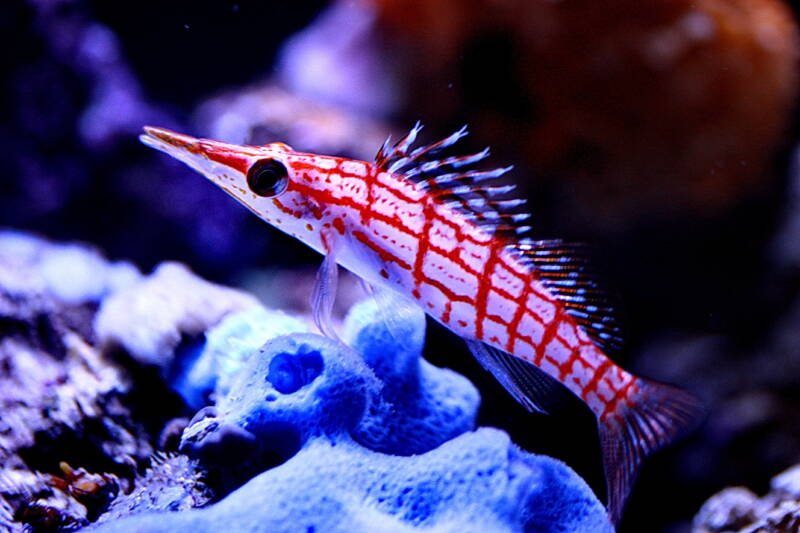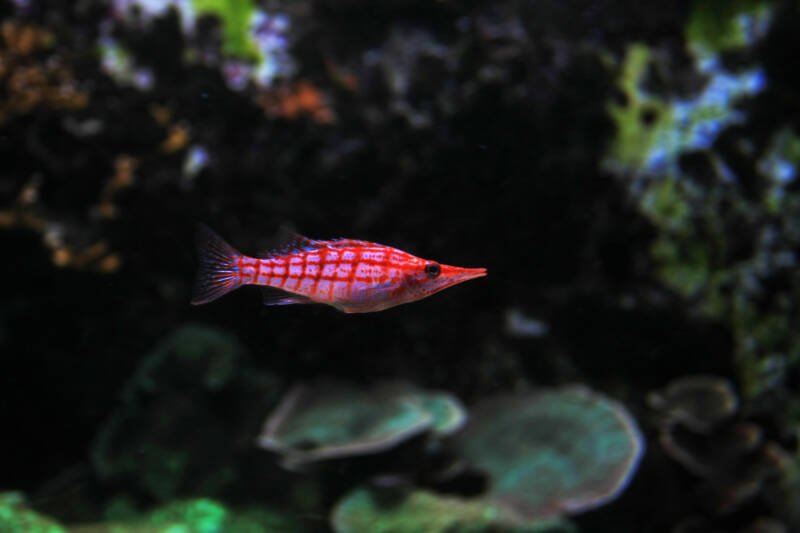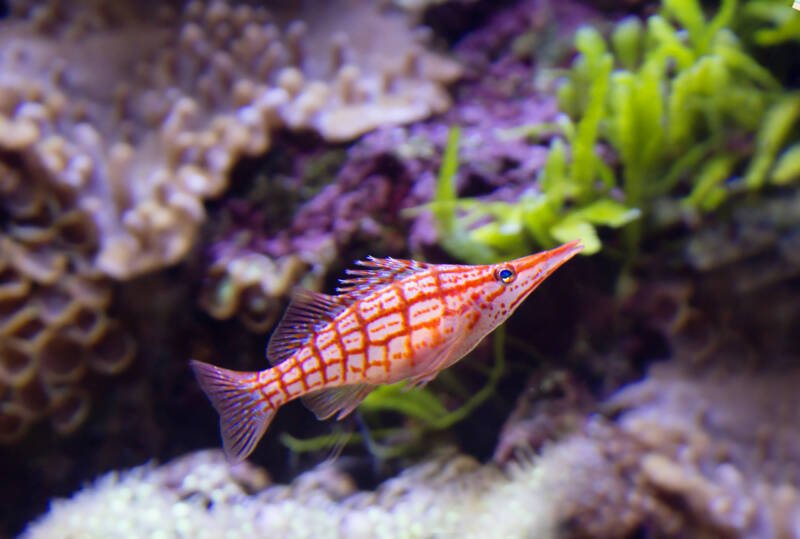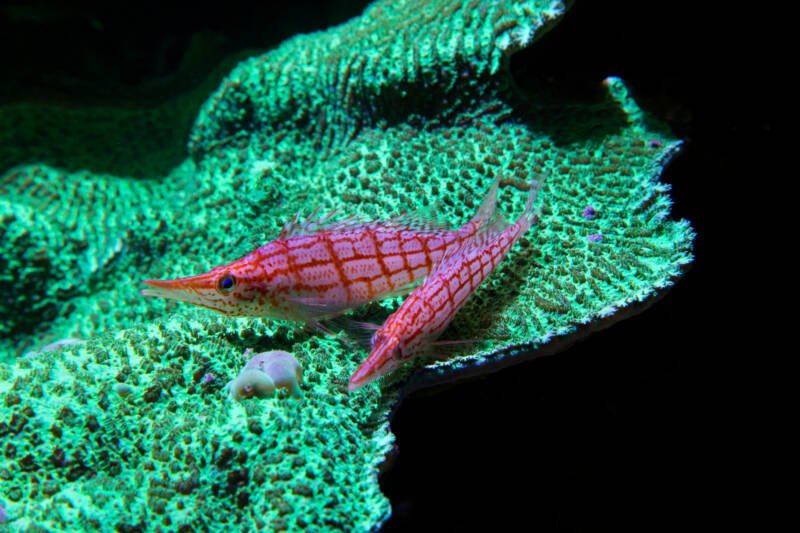If you’ve ever spent time examining certain reef tanks, you’ve probably noticed a curious little fish hanging out among the corals.
It perches on the ends of rocks and coral branches, surveying the aquarium around it. And then, out of the blue, it dives in a swoop!
With a stoop like a hawk, the curious hunting behavior gives the longnose hawkfish (Oxycirrhites typus) its name.
Similar to the bird of prey, it waits until the last moment to drop onto its target from above. And it’s just as effective a predator!

These plaid-striped fish look like a crazy combination between a lionfish, rockfish, and scorpionfish.
You see spines around the head and down the back, with cirri (pom-pom-like structures) at the tips. Then you have a squared-off tail at the end. Oh, and that narrow nose.
Longnose hawkfish are popular additions to saltwater aquariums. They’re also moderately easy to care for.
Of course, you need to take care to make them feel comfortable.
Because while they ARE successful predators – devastating crustaceans – they’re also prey items. It’s a balancing act.
At a Glance
- Tank Size: 60 gallons (227 l)
- School Size: One is safest
- Temperature: 75-80F (23.8-26.7C)
- pH:8.1-8.4
- Hardness: 8-12 dH
- Specific Gravity: 1.020-1.025
- Ammonia: 0 ppm
- Nitrite: 0 ppm
- Nitrate: < 10 ppm
- Lifespan: 5-7 years
- Size: 4-5 inches (10-13 cm)
In the Wild

Longnose hawkfish inhabit coral reefs throughout the Indo-Pacific region.
You’ll see them clustering in the Red Sea and down the eastern coast of Africa.
They also stretch down the Sea of Cortez to the Galapagos. (And, of course, you can spy them everywhere in-between)
They hug outer reef slopes where the current remains the strongest. This brings them their preferred prey items of fish and invertebrates.
Members of the hawkfish family, Cirrhitidae, lack swim bladders, so they’re NOT adept at swimming long distances to chase down a meal.
Instead, hawkfish perch on the branches of coral (black corals and gorgonians are particular favorites), waiting for something to “blow” past.
Once the fish or crustaceans are in range, they swoop down on top of it — no need for a swim bladder to provide buoyancy.
They’re adaptable enough to range from shallow water to a depth of 330 feet (100 m).
And that’s what makes them so tricky for divers to spot.
Red is the first color to disappear as you go down, allowing these plaid fish to vanish into the background of their coral hideouts.
The lines along their bodies provide the perfect cover as they drift back between the cross branchings of their particular coral perch.
So when a larger predator comes into the area (or a diver), they’re difficult to spot.
Size: Small and Mighty

While longnose hawkfish can easily decimate a local population of shrimp or tiny fish, they’re not the largest fish themselves.
They only come out to 4-5 inches (10—12.7 cm) at full size.
This is why their camouflage plaid pattern is so critical to protect them from hungry predators.
Lifespan
In the wild, hawkfish enjoy a lifespan between 5—7 years.
That isn’t too bad for a fish that relies on the mercy of water currents for most of its swimming ability. Not to mention that it’s on the menu of plenty of other fish.
In captivity, aquarists find a comparable lifespan for their longnose hawkfish.
Of course, you need to make sure you offer them proper water conditions and a suitable environment to stave off stress reactions.
Behavior

One of the most observable behaviors of longnose hawkfish is their perching.
They’ll prop themselves up on their pectoral fins to watch for any potential prey items.
Then they put on a burst of speed to snatch it up. This “perch and swoop” makes up for the lack of a swim bladder.
But that unique behavior is a solo one. Hawkfish DON’T tolerate sharing space.
And that’s true in the wild OR captivity. They’ll chase each other out of their chosen territory.
You’ll find razor-sharp teeth inside those narrow heads, capable of causing significant damage.
As such, you’re better off keeping ONE hawkfish in a tank at a time.
Otherwise, you’re going to cope with the less dominant fish getting forced into hiding – at the best of times. It will starve.
If you have a terrible situation, the dominant hawkfish will harass the other to DEATH.
Tank Setup

While longnose hawkfish aren’t the most impressive fish – in terms of size – you don’t want to crowd them in a tiny tank.
You should only keep one in an aquarium, but you don’t want to go smaller than 60 gallons (227 l).
And, honestly? If you want to make your little plaid fish feels comfortable, you should bump up to 100 gallons (379 l).
That will ensure it has room to explore and find the perfect perching site. Not to mention ensuring YOU have an easier time maintaining water quality.
Keep in mind that hawkfish are nocturnal. Some fish adapt to a diurnal life, but you don’t want to “blind” their sensitive eyes.
As such, you want to choose dimmer lighting. This will give you a chance to observe that hunting behavior. And it’ll keep your fish happier.
You’ll also need a sturdy lid for your aquarium. While they lack a swim bladder, longnose hawkfish CAN generate bursts of speed when they go after prey.
It’s strong enough to launch them OUT of a tank if there’s no barrier.
Water Conditions
As tropical species throughout their range, you want to make sure you have a quality heater on your reef tank.
Your water should stay within the range of 75-80F (23.8-26.7C). This is the same temperature they’re used to in the wild.
And that’s the theme for the other water parameters. You want to mimic saltwater’s specific gravity of 1.020-1.025, pH of 8.1-8.4, and hardness of 8-12 dH.
They’re narrow ranges but typical for the average saltwater aquarium.
You DO need to stay on top of your water quality, though. Longnose hawkfish won’t tolerate ammonia or nitrites.
And while you can get away with a SLIP of nitrates, you should aim to avoid it, if possible.
A protein skimmer might help if you don’t already have one.
Decorating the Longnose Tank
When it comes to tank décor, longnose hawkfish aren’t very demanding.
Their biggest request? Somewhere they can rest their pectoral fins and set up a watch for their next meal.
And maybe a quiet retreat for when they feel vulnerable.
You can easily provide perches with sea fans, LPS or SPS corals, live rock, or synthetic structures that mimic those things. (Your fish won’t be able to tell the difference, so there’s no harm there)
Set them up at different levels within the tank, with proper support, so nothing collapses.
If you have genuine corals within your tank, you don’t need to fret. Longnose hawkfish are reef-safe species.
However, those pectoral fins settling on the polyps can force them closed. And if you have soft corals, they can end up with irritation from the fish constantly perching atop them.
You also want to take care with adding certain species.
Catalaphyllia corals and sea anemones? They can sting and KILL hawkfish!
Then your poor fish will end up the meal of their perching spot. So make sure you research the corals you plan to use in the tank.
Longnose Hawkfish in Communities
As long as you avoid mixing hawkfish species, this small fish works nicely in communities.
They’ll happily get along with plenty of other fish. You need to take some precautions, but they don’t mind sharing tank space.
Tank Mates
That territorial nature? It can extend to non-hawkfish species.
As such, you want to make sure longnose hawkfish are the LAST fish you add to your saltwater tank. It will prevent any potential problems from cropping up.
Otherwise, you can combine them with most peaceful reef fish.
They won’t compete with swimming space since they prefer to hang out on the rock structures.
That means any of the following make ideal tank mates:
- Anthias
- Banggai cardinalfish
- Blue-green chromis
- Butterflyfish
- Clownfish
- Damselfish
- Dottybacks
- Dwarf angelfish
- Regal tangs
- Wrasses.
Incompatible Species
Longnose hawkfish ARE predators. And that means you need to take care with the invertebrates you keep in your reef tank.
Some of the smaller cleaner shrimp can quickly find themselves added to the menu. The same goes for hermit crabs and feather dusters.
Hawkfish have strong jaws, capable of crushing hard outer shells. This makes them effective for taking out crustaceans.
Plenty of saltwater shrimp species come out at night when the fish start hunting.
Make sure your crustaceans are large enough to survive a stalking hawkfish.
Food and Diet
Longnose hawkfish are effective carnivores. Most of their active hours (in the wild) are spent perching on coral branches or rock, waiting for a prey item to come within reach.
The shape of their teeth allows them to grab hold of their prey as they return to the safety of their perch.
You CAN teach a captive hawkfish to accept commercially prepared foods.
It involves some careful training. But you want to stick to proteins to keep them healthy and make sure those red stripes remain vibrant and healthy.
A variety of food options works best. (They don’t eat ONE crustacean or fish on the reefs)
Rotating your protein options – whether frozen or live – will keep your little ambush hunter happy:
- Brine shrimp
- Feeder fish (NOT goldfish)
- Mysis shrimp
Breeding Longnose Hawkfish: Sequential Hermaphrodites
If you want to tackle breeding longnose hawkfish, you’re in for a challenge.
It’s happened a few times successfully, but none of the fry survived.
The fact that these fish don’t get along creates problems. And so does the fact they’re sequential hermaphrodites – changing sex.
Male or Female? (And When?)
Hawkfish in the Cirrhitidae family are all protogynous hermaphrodites.
This means they’re born female, with the most dominant fish in a group switching to male.
And it’s usually the largest in a particular range that makes the change.
Male longnose hawkfish are larger than females (obviously – considering how they start in life).
They also develop a black fringe along their pelvic and caudal fins.
If you have a social situation where you have a SMALL male, they may not spawn successfully.
Spawning: Courtship Dances
In the wild, longnose hawkfish perform a courtship dance as part of the spawning process.
The male performs the same ritual with each female in his given territory each time the species spawns. And it begins shortly before sunset.
The male approaches a female on her coral perch, keeping his tail erect.
The two then alternate between circling the coral branches and pausing to rest. (No swim bladder, remember?)
The male then starts to nudge at the female with his nose, prompting the next stage.
The male mounts the female, resting his pectoral fins on her back and vigorously beating his tail.
The pair then orient themselves in a parallel position and swim toward the surface. At the top of the arch, they release eggs and sperm before returning to the safety of the coral.
Aquarists have attempted to replicate the conditions for this courtship dance with mixed results.
Trying to get a pair that tolerates sharing a tank is often the first hurdle.
And you that requires a TALL tank to accommodate the height needed during the courtship ritual.
Health and Diseases
Surprisingly for a saltwater species, longnose hawkfish come out on the healthy side of things.
You don’t find many parasites. And they’re not known to come down with illnesses very rapidly.
If you end up with an infection, your hawkfish will usually be the last to show signs.
That doesn’t mean you can skip the quarantine process, though.
You should still perform the usual 30-day quarantine and prophylactic dip.
And if you see your water quality dipping, you can still cause stress in your fish.
Longnose Hawkfish: Are They For You?
Due to the failure of captive breeding, longnose hawkfish come out on the expensive side of things.
You can expect to pay anywhere from $55-$80 per fish. As you should only house one fish at a time, though, this is a reasonable expense.
You don’t need to worry about expensive or unique décor or even particular dietary items.
That can help offset the cost of these colorful fish.
And if you can encourage them to venture out during the daylight hours? You’ll have an energetic hunting display to witness.
Plaid Perchers in a Reef Tank
Longnose hawkfish are unique saltwater fish. The lack of a swim bladder allows them to perch on structures within a tank – and swoop down on crustaceans or smaller fish.
And while you’ll need to spend a little more to add one to a tank, they’re worth it.
Do you have a longnose hawkfish? What lighting do you use?
What are the top diet items your hawkfish prefers?
Let us know your questions and stories here!